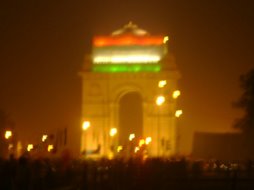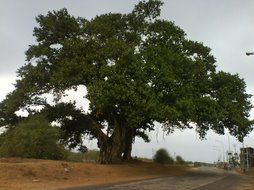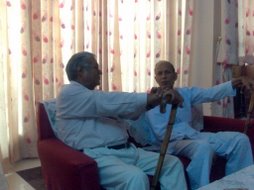Gurjars in Indian Army
Azad Hind Fauj
The Indian National Army (I.N.A) or Azad Hind Fauj was the army of the Arzi Hukumat-e-Azad Hind (The Provisional Government of Free India ) which fought along with the Japanese 15th Army during the Japanese Campaign in Burma, and in the Battle of Imphal, during the Second World War. It consisted mostly of Indian prisoners of war who, in the course of service in the British Army, had been captured by Axis forces, although a significant portion were recruited from Indian civilians in Japanese-controlled Malaya and Burma.
Gurjar soldiers and officers was in great number in Azad Hind Fauj. Among which Cap. Mukhram Singh, Cap. Surajmal and Col. Man Singh are the most mentionable names. Cap. Surajmal fought many successful battles and won the confidence of Netaji Subhash Chadra Boss and Genral Shah Nawaz Khan. Col. Man Singh also impressed every one with his inteligence and bravery. Gurjars soldires did not gave up even in unfavourable conditions. Netaji Subhash Chadra Boss himself appriciate their bravery and patrotism.
After Independence
After the partition of India on the basis of religion; Indian army was also divided, Muslim Gurjars of Punjab regiment were gone to the Pakistani army and Hindu Gurjars remained in the Indian Army. After the Second World War and before partition, Britishers permitted the formation of the Gurjar regiment in the Indian army, after looking at the great bravery and sacrifices of the Gurjars in the 2nd world war; but this issue was not being able to complete because of partition of India. Gurjar leaders also don’t force on it or may be they were thinking that the formation of the Gurjar regiment will be done in the Independent India; but partition of India vanish the hopes of the formation of the regiment.
Gurjar company of the Rajput regiment on every opportunity prove themselves as great fighters, as in police action of Hydrabad. When Pakistani Invaders entered into the Kashmir and occupied a wide area of riyasat then the Rajput regiment with their Gurjar companies was posted to protect the riyasat. Gurjar soldiers fought with great courage under the commands of Col. Girdhari Singh Gurjar and saved most of the region of Kashmir from Pakistan. 10 lakh of Gurjar of Kashmir also revolted and supported the Indian army. Pir Hazrat Nizamuddin Gurjar was a powerful leader who assures Sh. Ranbir that his Gurjar army is always with the peoples who are with India. Jauni Gurjari a brave woman who fought against the Kabailee attack while leading woman army. Her scarifies can not be forgotten by any one.
In 1962, China attacked India and war begins between the two nations. In this war brave Gurjar soldiers and officers of Rajput regiment fought with their full strength. Area near the Khijeman, Dhola, Sela army posts are still remembered by the name of Gurjar soldiers of 2nd Rajput regiment who fought there. In Ladhak and especially at Chusul post the bravery and sacrifice of the Gurjar soldiers can not be forgettable. In this brutal war with China many a thousand soldiers were killed, many Gurjar soldiers won medals for their sacrifice.
In 1965, Pakistan's "Operation Gibraltar" which was designed to infiltrate and invade Jammu&Kashmir, fighting broke out between India and Pakistan in an area known as the Rann of Kutch, Gujarat. This time also Gurjar officers of different regiments prove themselves as Greatest of fighters. At Mander, Uri, Punch Chamb, Sialkot etc. Gurjar soldiers of 6th Rajput regiment fought with great courage. Famous Kargil hills are most momentous as these hills are so close to the road which leads to Ladhak. These hills were won by the Gurjar Companies of 4th Rajput regiment by destroying the army post of Pakistanis. On September 22, the UNSC unanimously passed a resolution that called for an unconditional ceasefire from both nations. The war ended the following day. The Soviet Union, brokered a ceasefire in Tashkent, where Indian Prime Minister Lal Bahadur Shastri and Pakistani President Ayub Khan signed an agreement to withdraw to pre-August lines no later than February 25, 1966.
The war remained largely inconclusive despite Pakistan suffering relatively more losses, and saw a six year period of relative peace between the two neighboring rivals before war broke out once again in 1971. Very soon Indian government came to know the importance of Kargil hills which was given back to Pakistan as per Tashkent agreement. This time Pakistan strengthens its forces on the Kargil hills. So Indian army looking at past ones on Kargil, ordered 4th Rajput regiment to attack on Kargil hills. Gurjar soldiers immediately attacked with their full strength. This time it was not easy to recapture the hills but the bravery and sacrifice of Gurjar soldiers let them won the hills. Battle of longewala is generally regarded to be one of the decisive battles in the two week long war. Against considerable odds, the Indian 'A' company of 120 odd soldiers of the 23rd Bn, The Punjab Regiment,led by Major Kuldeep Singh Chandpuri, managed to repulse a 2000-3000 strong 51st Infantry Brigade backed by the 22nd Armoured Regiment of Pakistan. For his part, the Indian company commander Major (later Brigadier) Kuldip Singh Chandpuri was decorated with India's second highest gallantry award, the Maha Vir Chakra. (Battle of Longewala : Movie-Border)
It is high time to consider about the old demand of the formation of Gurjar regiment in the Indian army.



No comments:
Post a Comment